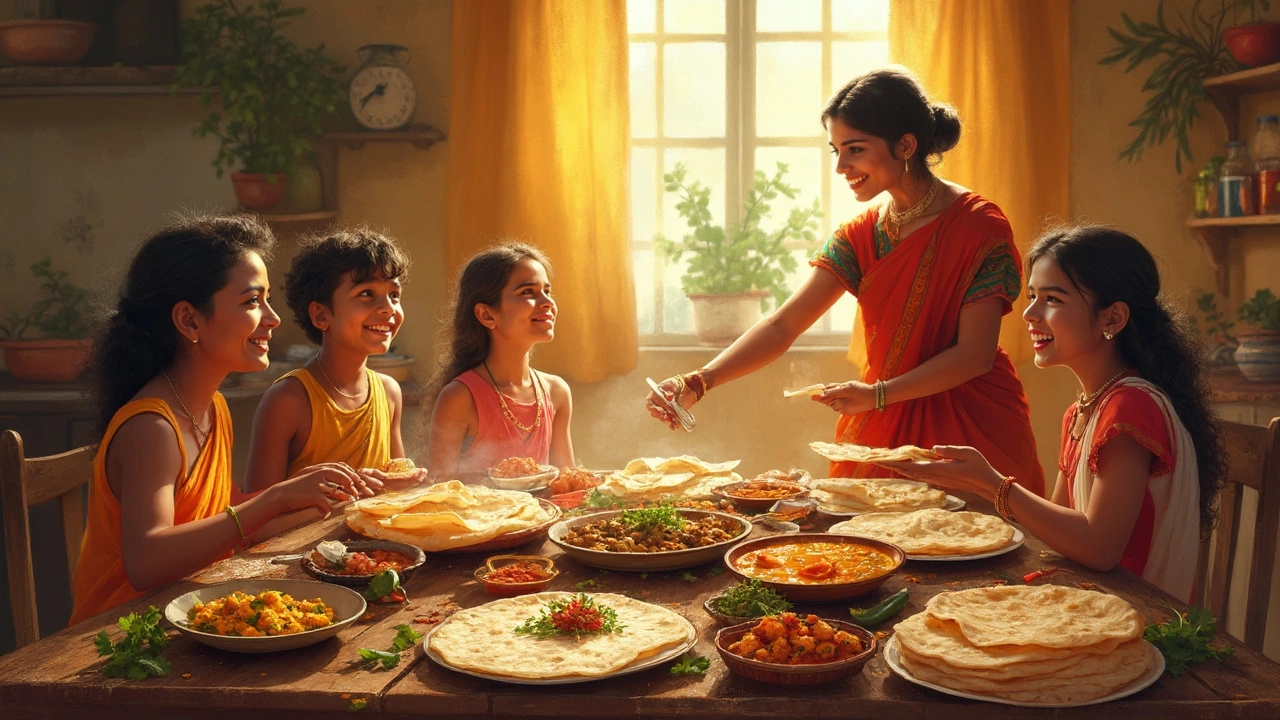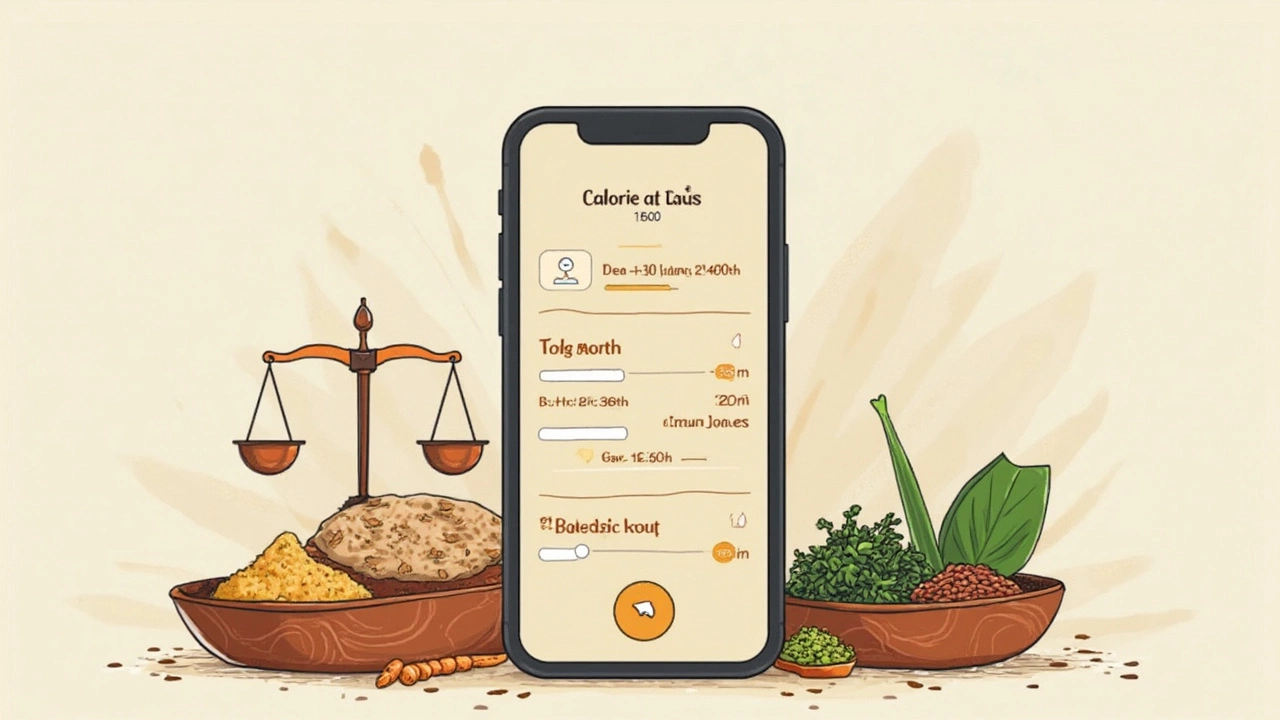How Many Chapatis Can You Eat Without Gaining Weight?
 Mar, 5 2025
Mar, 5 2025
So, you love chapatis but worry about gaining weight? You're not alone. Understanding how many chapatis you can eat without ballooning up involves a bit of number-crunching—specifically looking at calories and your Body Mass Index (BMI).
Your BMI is a simple calculation of your weight in relation to your height. It's an indicator of whether you're in a healthy weight range. But how does this relate to chapatis? Well, like any food, if you consume more calories than your body needs, it could lead to weight gain. That's where knowing the calories in one roti becomes crucial.
Most rotis pack around 70-120 calories, depending on size and ingredients. The dietary trick is balancing these calories within your daily intake. Using a calorie calculator can help. Input your weight, height, age, and activity level to see how many calories you should be consuming each day. This will guide you in determining how many chapatis fit into your diet.
- Understanding BMI and Calories
- Calories in One Roti
- How Many Chapatis Should You Eat in a Day
- Balancing Tradition and Nutrition
Understanding BMI and Calories
Let's break down BMI and why it matters when you're thinking about how many chapatis to munch on. BMI, or Body Mass Index, is a simple number calculated from your height and weight. It's often used as a quick way to see if you're carrying the right amount of weight for your height, but remember, it doesn’t directly measure body fat. It's a ballpark figure. You get your BMI by dividing your weight in kilograms by your height in meters squared. Generally, a BMI of 18.5 to 24.9 is considered healthy.
Why should you care? Well, knowing your BMI can help you decide how many calories – like those in chapatis – you should be eating. You probably know that losing, gaining, or maintaining weight is pretty much a numbers game. Eat more calories than you burn, and the scale goes up. Eat less, and it comes down. It's that simple!
Calculate Your Calorie Needs
To figure out how many chapatis you can eat without gaining weight, first calculate your daily calorie needs. Here's a quick how-to:
- Use a calorie calculator. You can find tons of these online. They're super handy!
- Input your weight, height, age, and level of physical activity. This tells you how many calories you burn just living life – it's called your maintenance calories.
- Plan your meals to fit these needs. If you’re active, you can wiggle in a few more chapatis, but be honest with yourself about your activity level!
Legal-wise, most places don't have specific regulations about how many chapatis you should eat, but they're part of a balanced diet. In India, where chapatis are a staple, traditional wisdom often emphasizes balance over strict rules. Enjoying a chapati-based diet while keeping an eye on your BMI and calorie intake is key. That way, you savor what you eat without the worry.
A quick look at calorie burning can also help. For example, a brisk 30-minute walk lets you burn about 150 calories, roughly equivalent to two small rotis. This means lifestyle tweaks, like parking further away or taking stairs, can help keep the scales in your favor.
| Activity | Calories Burned (30 mins) |
|---|---|
| Walking (brisk pace) | 150 |
| Yoga | 120 |
| Jogging | 300 |
Calories in One Roti
Digging into the calories in one roti is like opening a window into your diet. Rotis, a staple in many diets, are primarily made from whole wheat flour, water, and sometimes a dash of oil or ghee for flavor. But how does that add up calorie-wise?
A standard roti is usually around 6 inches in diameter and contains roughly 70-120 calories. The exact count can shift depending on variations. Want to make it at home? Here's what you might put into it:
- 1 cup whole wheat flour: 400 calories
- 1/2 cup water: 0 calories
- 1 tsp oil: 40 calories (optional)
These ingredients will get you around 8 rotis, keeping it pretty cost-effective both for your wallet and your waistline.
What the Experts Say
According to the National Institute of Nutrition, "Chapatis made with whole wheat flour have a lower glycemic index, which is beneficial in controlling blood sugar spikes."
Given that, if you’re focused on maintaining or losing weight, sticking to whole wheat could offer some added benefits.
Considering Local Variations
India’s diverse regions have given rise to numerous roti varieties. For instance, in Punjab, adding ghee or butter is common, which can spike the calorie content. On the flip side, chapatis in more health-conscious areas might skip the extra fat, making them a lighter choice.
Legal Aspects of Food Labeling
Interestingly, the Food Safety and Standards Authority of India (FSSAI) mandates clear labeling of food products, so if you're buying pre-packaged rotis, you should find nutritional info right on the pack. This transparency helps you keep track of your intake more accurately.
When discussing healthy eating, two things are key: awareness and moderation. Knowing the calories in your chapati and understanding its place in your daily diet are essential steps in enjoying this traditional staple without the worry of unintended weight gain.

How Many Chapatis Should You Eat in a Day
Determining the number of chapatis you can enjoy daily without veering off the healthy lane isn't just about the love for rotis. It's a bit math-y and a bit personalized. Let's break it down.
Step 1: Determine Your Caloric Needs
To figure out how many calories you should consume daily, consider your age, weight, height, and activity level. Use a calorie calculator to make things easy.
Step 2: Calculate Calories for Your Entire Meal
If one roti is about 80 calories, and your daily intake is around 2000, you get an idea of how to portion your chapatis. But remember, you'll be eating other things too!
Step 3: Balance with Other Foods
- Include proteins like dal or chicken curry alongside your chapatis.
- Add vegetables for fiber and nutrients.
- Consider light snacks or fruit bowls to spread your calorie intake.
Legal and Local Aspects
There's no law about how many chapatis you can eat (thank goodness!), but health guidelines often emphasize balance. Locally, in South Asia, chapatis are a staple, so culturally, meals tend to balance carbohydrates with proteins and veggies. Whether you're in Mumbai or Mitra Nagar, understanding local diet patterns can help.
Adjustments for Weight Goals
If you aim to lose weight, cut back a bit on the rotis, and if you're maintaining, stick to your caloric needs. Some health enthusiasts suggest starting with three chapatis and adjusting based on hunger and fullness cues.
| Activity Level | Recommended Chapatis |
|---|---|
| Sedentary | 2-3 chapatis |
| Moderately Active | 4-5 chapatis |
| Very Active | 5-6 chapatis |
So, grab your calorie calculator and see what fits best for you. The key to a healthy relationship with chapatis? Moderation and balance!
Balancing Tradition and Nutrition
Enjoying chapatis is deeply rooted in tradition, especially in Indian households. They represent not just a staple, but also a symbol of cultural heritage. Balancing this with nutritional needs is the key to health without sacrificing tradition.
Understanding Ingredients
First things first, consider the ingredients of your chapati. Traditionally made from whole wheat flour, this gives it a good dose of fiber. But if you're adventurous, try adding other healthy flours like ragi or bajra into the mix for added nutrients.
Portion Control
You might wonder, how many chapatis should you eat in a day without impacting your BMI? It really depends on your overall caloric needs, which a calorie calculator can help determine. Typically, 2-3 chapatis per meal are ideal for an average adult, but always adjust based on your activity level.
Pairing Wisely
What you eat with your chapati also matters. Balance your meal with vegetables, protein like dal or chicken, and avoid excess oil or butter. This ensures your meals remain healthy and light.
Adapting Traditions Locally
In certain regions, legal guidelines might exist concerning nutrient fortification in staples. Understanding these can guide how you make or buy your chapatis. Always stay informed about any regulations in your area.
Remember Your Roots
Finally, eating is as much about joy and tradition as it is about nutrition. Embrace your local eating habits, but stay mindful of your body's needs. By blending tradition with modern nutritional practices, your BMI can stay in check while you savor that delightful roti.